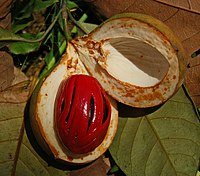
Photo from wikipedia
Pandemics of vector-borne human and plant diseases often depend on the behaviors of their arthropod vectors. Arboviruses, including many bunyaviruses, manipulate vector behavior to accelerate their own transmission to vertebrates,… Click to show full abstract
Pandemics of vector-borne human and plant diseases often depend on the behaviors of their arthropod vectors. Arboviruses, including many bunyaviruses, manipulate vector behavior to accelerate their own transmission to vertebrates, birds, insects, and plants. However, the molecular mechanism underlying this manipulation remains elusive. Here, we report that the non-structural protein NSs of Tomato spotted wilt orthotospovirus, a prototype of the Tospoviridae family and the Orthotospovirus genus, is a key viral factor that indirectly modifies vector preference and increases vector performance. NSs suppresses the biosynthesis of plant volatile monoterpenes, which serve as repellents of the vector western flower thrips (WFT, Frankliniella occidentalis). NSs directly interacts with MYC2, the jasmonate (JA) signaling master regulator and its two close homologs MYC3 and MYC4, to disable JA-mediated activation of terpene synthase genes. The dysfunction of the MYCs subsequently attenuates host defenses, increases the attraction of thrips, and improves thrips fitness. Moreover, MYC2 associated with NSs of Tomato zonate spot orthotospovirus, another Euro/Asian-type orthotospovirus, suggesting that MYC2 is an evolutionarily conserved target of Orthotospovirus species for suppression of terpene-based resistance to promote vector performance. These findings elucidate the molecular mechanism through which an orthotospovirus indirectly manipulates vector behaviors and therefore facilitates pathogen transmission. Our results provide insights into the molecular mechanisms by which Orthotospovirus NSs counteracts plant immunity for pathogen transmission.
Journal Title: PLoS Pathogens
Year Published: 2019
Link to full text (if available)
Share on Social Media: Sign Up to like & get
recommendations!